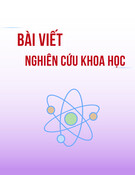
VNU Journal of Science: Mathematics – Physics, Vol. 41, No. 1 (2025) 69-80
69
Original Article
Optical Simulations of Organic Solar Cells
with PBDB-T:ITIC and PTB7:PC71BM Photoactive Layers
Nguyen Duc Cuong*, Than Thi Thu Ha, Hoang Thi Hoa,
Vu Thi Thao, Nguyen Tuan Canh, Nguyen Phuong Hoai Nam
VNU University of Engineering and Technology, 144 Xuan Thuy, Cau Giay, Hanoi, Vietnam
Received 21st December 2024
Revised 6th February 2025; Accepted 20th February 2025
Abstract: In this work, we present a comprehensive optical simulation analysis of bulk-
heterojunction (BHJ) organic solar cells where PBDB-T:ITIC incorporated with PTB7:PC71BM
blends served as photoactive layers. The simulations were performed using transfer matrix method
implemented through a MATLAB script that is developed by McGehee’s research group at Stanford
University. This method involves calculating the optical transmission and reflection at each interface
within the multilayer stack, as well as the attenuation of light within each layer. A comparative
evaluation was conducted for solar cells employing these active layers in both conventional and
inverted configurations, with a focus on key performance metrics including light-harvesting
efficiency (LHE), exciton generation rate within the active layer (𝐺AL(𝑥, 𝜆)), and the maximum
achievable short-circuit current density (𝐽SC-max). The obtained results showed that for both types of
active layers, the inverted structure achieves a larger 𝐽SC-max compared to the conventional structure.
Additionally, the PBDB-T:ITIC-based absorber outperforms the PTB7:PC71BM-based absorber in
terms of 𝐽SC-max.
Keywords: Organic solar cells, optical simulations. *
1. Introduction
Highly efficient organic solar cells (OSCs) are predominantly based on blends of electron-donor
materials and fullerene-based electron-acceptor materials (fullerene acceptors, FAs) to form bulk
heterojunctions (BHJs) within the devices. However, non-fullerene acceptors (NFAs) have become a
principal focus of research in the development of BHJ OSCs due to their numerous advantageous
properties [1]. Since 2015, concerted materials synthesis and device optimization efforts have improved
________
* Corresponding author.
E-mail address: cuongnd@vnu.edu.vn
https://doi.org/10.25073/2588-1124/vnumap.4980

N. D. Cuong et al. / VNU Journal of Science: Mathematics – Physics, Vol. 41, No. 1 (2025) 69-80
70
the power conversion efficiencies (PCEs) for NFA OSCs from 6% to larger 13% [2, 3], thus outpe
rforming their fullerene counterparts (which have PCEs <13%) [4, 5].
3,9-bis(2-methylene-(3-(1,1-dicyanomethylene)-indanone))-5,5,11,11-tetrakis(4-hexylphenyl)-
dithieno[2,3-d:2’,3’-d’]-s-indaceno[1,2-b:5,6-b’]dithiophene (ITIC) marks the advent of a new
generation of small-molecule NFAs for OSCs. The energy levels of ITIC are well-aligned with low
band-gap conducting polymers, enhancing charge separation efficiency and minimizing energy loss.
ITIC molecules exhibit strong and broad absorption characteristics spanning from the visible to the near-
infrared regions of the electromagnetic spectrum, with a peak absorption at 700 nm [6]. This broad
absorption potential increases the overall light-harvesting capability of OSC devices, thereby improving
PCEs. These attributes have established ITIC as the first small molecule electron acceptor to surpass the
performance of the leading fullerene acceptor [6,6]-Phenyl-C71-butyric acid methyl ester (PC71BM) in
OSC devices fabricated under controlled conditions, such as in a glove box. When paired with Poly[(2,6-
(4,8-bis(5-(2-ethylhexyl)thiophen-2-yl)-benzo[1,2-b:4,5-b’]dithiophene))-alt-(5,5-(1’,3’-di-2-thienyl-
5’,7’-bis(2-ethylhexyl)benzo[1’,2’-c:4’,5’-c’]dithiophene-4,8-dione)] (PBDB-T) in an inverted-
architecture device, ITIC achieved a PCE exceeding 11%, compared to a PCE of less than 8% when
PC71BM was utilized as the electron acceptor [6]. This result originates from the broader absorption
spectrum and more suitable energy level alignment of PBDB-T:ITIC compared to PBDB-T:PC71BM.
As reported in [6], during the exciton dissociation process in a BHJ blend film, electrons transition from
the lowest unoccupied molecular orbital (LUMO) of the donor to the LUMO of the acceptor, while holes
migrate from the highest occupied molecular orbital (HOMO) of the acceptor to the HOMO of the donor.
The energy gap ΔLUMO= LUMOdonor − LUMOacceptor in the PBDB-T:ITIC blend is 0.2 eV smaller than
that in the PBDB-T:PC71BM blend, while the energy gap ∆HOMO= HOMOdonor − HOMOacceptor in the
PBDB-T:ITIC blend is 0.45 eV smaller than in the PBDB-T:PC71BM blend. These reductions play a
crucial role in minimizing energy loss during exciton dissociation when transitioning from the PBDB-
T:PC71BM to the PBDB-T:ITIC system. On the other hand, PC71BM is more compatible with Poly [[4,8-
bis[(2-ethylhexyl)oxy]benzo[1,2-b:4,5-b']dithiophene-2,6-diyl][3-fluoro-2-[(2-ethylhexyl)carbonyl]
thieno[3,4-b]thiophenediyl ]] (PTB7) than ITIC. The absorption spectra of ITIC and PTB7 overlap
significantly, preventing the advantages of ITIC from being fully realized when blended with PTB7.
Typical reported PCEs of high-performance PTB7:PC71BM organic solar cells are 8.24% for the
conventional structure and 9.214% for the inverted structure [7].
It is well-established that the working mechanism of BHJ OSCs involves four primary steps: i)
Exciton generation; ii) Exciton diffusion; iii) Exciton dissociation into free electron and hole; and iv)
Charge transport and collection [1]. In this work, to elucidate the efficiency of the initial step in the
working mechanism of OSCs utilizing FAs and NFAs, we selected two representative blends: PBDB-
T:ITIC and PTB7:PC71BM. These blends were subjected to comparative analysis through optical
simulations. Both conventional and inverted structures were employed, and their optical performances
were compared, including the exciton generation rate within the active layer (𝐺AL), light-harvesting
efficiency (LHE), and the maximum short-circuit current (𝐽SC-max).
2. Simulation Model
Optical constants are fundamental parameters that describe how materials interact with
electromagnetic waves, particularly with light. The primary optical constants are the refractive index (n)
and the extinction coefficient (k). The refractive index (𝑛 = 𝑐
𝑣) indicates how much light is bent, or
refracted, as it enters the material, while the extinction coefficient (k) represents the degree of light
absorption within the material [8]. Together, these constants define the complex refractive index, 𝑛 =

N. D. Cuong et al. / VNU Journal of Science: Mathematics – Physics, Vol. 41, No. 1 (2025) 69-80
71
𝑛 + 𝑖𝑘, which influences how light propagates, reflects, and absorbs in various media. Optical constants
are critical in fields such as optics, material science, and photonics for understanding and designing
optical devices such as solar cells. Typically, the wavelength-dependent values of n and k are derived
through ellipsometric analysis of thin-film materials [9]. Ellipsometry is a powerful, non-destructive
optical technique that enables precise characterization of the optical constants by measuring changes in
the polarization state of reflected or transmitted light. The amplitude ratio 𝜓 and phase difference 𝛥
between p- and s-polarized light waves were directly acquired from experimental measurements.
Subsequently, the optical constants (refractive index n and extinction coefficient k) were determined by
applying an optical model appropriate to the sample under investigation. This method is especially
valuable for thin films, as it provides insights into layer thickness, surface morphology, and optical
properties essential for applications in materials science and photonics.
Optical simulations of stacked-structure OSCs were conducted using a modified MATLAB script
developed by the McGehee group at Stanford University [10, 11]. In this MATLAB script, the transfer
matrix method was employed to compute transmission and reflection at each interface within the stack,
alongside the attenuation in each layer [12, 13]. These calculations are grounded in the optical constants
of the constituent materials, ensuring accurate modeling of light interactions across interfaces and within
layers. In this work, the stacked structure and thickness of each layer in both conventional and inverted
OSCs, utilizing two types of active layers (AL), are as follows:
Conventional structure:
ITO(160nm)/PEDOT:PSS(40nm)/AL(varying thickness)/LiF(1nm)/Al(120nm).
Inverted structure:
ITO(160nm)/ZnO(50nm)/AL(varying thickness)/MoO3(10nm)/Ag(120nm).
In both configurations, the devices are illuminated from the indium tin oxide (ITO) side, with the
metal electrodes (aluminum and silver) functioning as reflectors. The optical constant database for the
PBDB-T:ITIC and PTB7:PC71BM organic blends AL is sourced from the works by Kerremans et al.,
and Stelling et al., respectively [14, 15]. In these studies, the weight ratios of 1:1 and 1:1.6 were
employed for PBDB-T:ITIC and PTB7:PC71BM organic blends, respectively. Wavelength-dependent
optical constants (n, k) for each material as shown in Fig. 1, including ITO, Poly(3,4-
ethylenedioxythiophene):Polystyrene sulfonate (PEDOT:PSS), lithium fluoride (LiF), zinc oxide
(ZnO), molybdenum oxide (MoO3), aluminum (Al), silver (Ag), organic blends (PBDB-T:ITIC and
PTB7:PC71BM) were compiled into a single Excel file, which served as input data for the MATLAB
script. Additionally, the script incorporated the names of materials constituting the cell structure along
with their corresponding thicknesses (in nanometers). The standard solar irradiation spectrum data
(AM1.5 Global) 𝛷(𝜆), which has an integrated power of 100 mW/cm2, were also included. Simulations
were conducted over a wavelength range of 300 to 800 nm. The output data from the calculations
comprised internal optical electric field (𝐸𝑗(𝑥, 𝜆)), exciton generation rate within the active layer
(𝐺AL(𝑥, 𝜆)), light-harvesting efficiency (LHE(𝜆)), and maximum short-circuit current (𝐽SC-max).
The exciton generation rate at position x within layer j at a specific wavelength 𝜆 was calculated
according to [12]:
𝐺𝑗(𝑥, 𝜆)=𝜆
ℎ𝑐𝑄𝑗(𝑥, 𝜆) (1)
where 𝑄𝑗(𝑥, 𝜆)=4𝜋𝑐𝜀0𝑛𝑗𝑘𝑗
2𝜆 |𝐸𝑗(𝑥, 𝜆)|2 is the time average of the energy dissipated per second in layer j
at position x at normal incidence, c is the speed of light, 𝜀0 is the permittivity of free space, and 𝐸𝑗(𝑥, 𝜆)
is the internal optical electric field.
The position-dependent exciton generation rate (𝐺AL(𝑥)) within the active layer was determined by
integrating over the entire desired wavelength range:

N. D. Cuong et al. / VNU Journal of Science: Mathematics – Physics, Vol. 41, No. 1 (2025) 69-80
72
𝐺AL(𝑥)=∫𝐺AL(𝑥, 𝜆)𝑑𝜆
𝜆max
𝜆min (2)
The wavelength-dependent light-harvesting efficiency (LHE(𝜆)) was calculated according to:
LHE(𝜆)=𝑁exciton in AL
𝑁photon =∫𝐺AL(𝑥,𝜆)𝑑𝑥
𝑑AL
0
𝛷(𝜆).𝜆
ℎ𝑐
(3)
where 𝑁exciton in AL and 𝑁photon are the numbers of excitons generated within the active layer and the
number of incident photons in a unit of time, respectively. 𝑑AL is the thickness of the active layer.
Assuming that the efficiency of all subsequent steps following exciton generation is 100%, the
maximum short-circuit current 𝐽SC-max was calculated according to:
𝐽SC-max = 𝑒 ∫𝐺AL(𝑥)𝑑𝑥
𝑑AL
0 (4)
Notably, this value is invariably higher than the short-circuit current (𝐽SC) achievable in an actual
organic solar cell with the same configuration. This discrepancy arises from the unavoidable losses
during exciton diffusion, exciton dissociation, and charge transport and collection processes.
Figure 1. Wavelength-dependent optical constants (n, k) of (a) ITO, PEDOT:PSS (CLEVIOS P VP AI 4083),
MoO3, ZnO; (b) PBDB-T:ITIC and PTB7:PC71BM organic blends, and (c) Ag and Al [14, 15].
The data of LiF are not shown.

N. D. Cuong et al. / VNU Journal of Science: Mathematics – Physics, Vol. 41, No. 1 (2025) 69-80
73
Table 1. Semiconductor physical parameters of the materials constituting the organic solar cells.
Material
Parameter
PEDOT:PSS
MoO3
ZnO
PBDB-T:ITIC
PTB7:PC71BM
d (nm)
40
10
50
0–250
0–250
𝐸𝑔 (eV)
2.786
3.0
3.4
1.2
1.05
𝜒 (eV)
2.2
2.5
4.25
4.03
4.1
𝜇𝑒 (cm2⋅ V−1 ⋅ s−1)
1 × 10−5
25
50
3.1 × 10−4
5.1 × 10−4
𝜇ℎ (cm2⋅ V−1 ⋅ s−1)
3.2 × 10−4
100
20
3.2 × 10−4
5.2 × 10−4
References
[16]
[17]
[18–20]
[6, 16, 21, 22]
[6, 16, 21, 22]
3. Results and Discussion
As discussed in the Introduction, the initial stage in the operational mechanism of an organic solar
cell involves photon absorption and exciton generation. When photons are absorbed within the active
layer, excitons are formed, and their generation rates vary across different spatial positions within this
layer. Achieving high LHE and an optimal exciton generation rate profile is essential for the
development of high-performance solar cells.
Subsequent stages involve the diffusion of excitons to the donor-acceptor interface, where they
dissociate to produce charge carriers: electrons at the LUMO of the acceptor material and holes at the
HOMO of the donor material. These charge carriers are then transported through the respective donor
and acceptor networks before being collected at the corresponding electrodes. The semiconductor
physical parameters, including energy bandgap, electron affinity, and charge carrier mobilities of the
materials comprising the organic solar cells, are summarized in Table 1. The organic blends are modeled
as single semiconductor layers, with the bandgap (𝐸𝑔) defined by the energy difference between the
HOMO level of the donor materials (PBDB-T, PTB7) and the LUMO level of the acceptor materials
(ITIC, PC71BM).
Due to the inherently low charge carrier mobility of organic materials (see Table 1), the active layer
is typically kept relatively thin (100–200 nm). A uniform exciton generation rate within the active layer
facilitates efficient charge carrier transport and collection, contributing to an increased short-circuit
current density (𝐽SC) and, consequently, an improved PCE.
The wavelength-dependent LHE spectra for varying thicknesses of the active layer are presented in
Fig. 2. Figures 2(a) and 2(c) demonstrate that for the PBDB-T:ITIC blend, notable variations in LHE
with different active layer thicknesses are evident in the wavelength ranges of 350–550 nm and 700–
770 nm. Conversely, the LHE curves for the PTB7:PC71BM blend exhibit distinctions across the entire
wavelength spectrum, as illustrated in Figs. 2(b) and 2(d). As denoted in a previous study by Zhao et al.,
the absorption spectrum of the PBDB-T is complementary with that of ITIC, such that the onset of
extinction coefficient k for the PBDB-T:ITIC blend, as shown in Fig. 1, and consequently the onset of
LHE in Figs, 2(a) and 2(c), is determined by the onset at approximately 770 nm in the absorption
spectrum of ITIC [6]. The absorption spectrum onset of PTB7:PC71BM is determined by the absorption
edge of the PTB7 polymer, at approximately 750 nm [23], which is consistent with the 𝑘(𝜆) and LHE
spectra. Therefore, it can be concluded that the broader LHE spectrum of the PBDB-T:ITIC blend, in
comparison with PTB7:PC71BM, originates from its broader absorption and 𝑘(𝜆) spectra. Additionally,
due to the lower extinction coefficient of the PTB7:PC71BM blend, a thicker active layer is necessary to
achieve a LHE comparable to that of PBDB-T:ITIC blend. Figure 3 illustrates the dependence of average
LHE values, measured over the wavelength range from 300 to 800 nm, on the thickness of the active

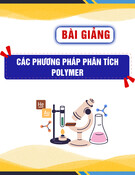
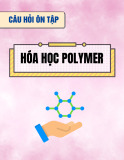

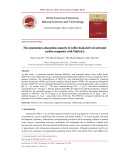
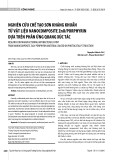
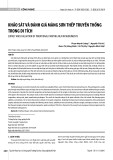
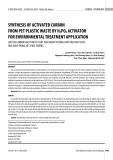
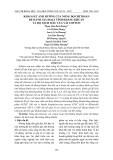

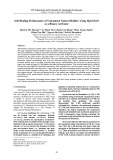




![Ô nhiễm không khí từ nông nghiệp: Thách thức toàn cầu và định hướng hành động [Mới nhất]](https://cdn.tailieu.vn/images/document/thumbnail/2025/20250917/kimphuong1001/135x160/52891758099584.jpg)







